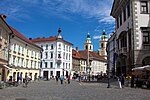Ljubljana Cathedral
1706 establishments in the Holy Roman Empire18th-century Roman Catholic church buildings in SloveniaBaroque church buildings in SloveniaCenter District, LjubljanaChurch buildings with domes ... and 6 more
Churches destroyed by arsonCultural monuments of SloveniaInfobox religious building with unknown affiliationRoman Catholic cathedrals in SloveniaRoman Catholic churches completed in 1706Roman Catholic churches in Ljubljana

Ljubljana Cathedral (Slovene: ljubljanska stolnica), officially named Saint Nicholas's Church (cerkev sv. Nikolaja, unofficially also šenklavška cerkev), also named Saint Nicholas's Cathedral (Slovene: stolnica sv. Nikolaja), the Cathedral of Saint Nicholas, or simply the Cathedral (Stolnica), is a cathedral in Ljubljana, the capital of Slovenia. Originally, Ljubljana Cathedral was a Gothic church. In the early 18th century, it was replaced by a Baroque building. It is an easily recognizable landmark of the city with its green dome and twin towers and stands at Cyril and Methodius Square (Ciril-Metodov trg) by the nearby Ljubljana Central Market and Town Hall.
Excerpt from the Wikipedia article Ljubljana Cathedral (License: CC BY-SA 3.0, Authors, Images).Ljubljana Cathedral
Mačkova ulica, Ljubljana Trnovo
Geographical coordinates (GPS) Address Nearby Places Show on map
Geographical coordinates (GPS)
| Latitude | Longitude |
|---|---|
| N 46.050555555556 ° | E 14.507777777778 ° |
Address
Škofijski dvorec (Škofijska palača;Nadškofijski dvorec;Nadškofijska palača)
Mačkova ulica
1104 Ljubljana, Trnovo
Slovenia
Open on Google Maps









